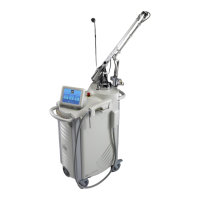Safe Start Protocol for
BBL/BBLs Non-Ablative
Pigmented Lesion/Skin
Treatment
Pulse width should be shorter than the cooling time of
the target to make sure that all the energy is confined
to the target. Smaller objects cool faster than larger
ones. Therefore, the smaller the lesion being treated,
the less time on or a shorter pulse width needed.
Conversely, when treating a larger lesion, a longer
pulse width should be selected to provide for a longer
period of heat delivery. Pigmented lesions with low
concentrations of pigment will cool down quicker
than densely pigmented ones. Therefore, “lighter’, less
concentrated areas of lesions should be treated with
shorter pulse widths and “darker”, more concentrated
areas of lesions should be treated with longer pulse
widths. Darker skin absorbs more light and heats to a
higher temperature, therefore pulse width should be
longer for darker skin.
Cooling
Refer to Pigmented Lesion Treatment Starting
Parameters for appropriate temperature selection.
Although absorption of the BBL light in melanin is
desirable, some epidermal cooling is essential to
protect the skin. The amount of cooling required will
vary with skin type, amount of target present, and
area treated. The temperature of the BBL crystal
should be colder when treating areas of darker
and/or more densely populated pigment. When
treating body tissue, temperature should be colder, as
well as when treating darker skin types.
Treatment Basics
1. Apply thin layer of colorless gel
2. Select appropriate settings
3. Treat test area to establish safe treatment
parameters and desired endpoint.
4. Once appropriate settings are selected, complete
treatment area.
Endpoint
1. Erythema
2. Vessels may disappear, darken, lighten or appear
unchanged but fade over time. When capillary refill
test is performed, blood flow is static.
3. Urticaria or a “cat scratch” appearance to the
treated vessel.
4. Possible Purpura
BBL Pigmented Lesion Treatment Starting
Parameters – Facial Tissue
I - II with light
solar
damage
I - II with
heavy solar
damage
Note: Decrease fluence 15 - 20% over bony areas such as collar bones,
shoulders, etc. Increase fluence 1 - 2J/cm2 when using any of the BBL snap
on adapters.
BBL Pigmented Lesion Treatment Starting
Parameters – Body Tissue
I - II with light
solar damage
I - II with heavy
solar damage
Note: Decrease fluence 15 - 20% over bony areas such as collar bones,
shoulders, etc. Increase fluence 1 - 2J/cm2 when using any of the BBL snap
on adapters.
Post Treatment
1. Observation – Erythema for several hours after treatment
2. Intervention – Cool compresses or ice packs can provide
some comfort after treatment. If blistering occurs,
aggressive wound healing measures should be
implemented.
3. Interval – Treatments are performed 3 - 4 weeks apart. 3 -
5 treatments may be required.
4. If performing a BBL Pigmented Lesion treatment in
conjunction of other procedures such as MLP or
ProFractional, perform the pigmented lesion treatment
first.
5. Check with manufacturer for guidelines on using
injectables in conjunction with BBL pigmented Lesion
treatments.
The BBL Non-Ablative Pigmented Lesion/Skin Treatment
Protocol is effective for treating hyperpigmentation, sun
damage, brown spots, age spots, liver spots, brown
pigmented scars, birthmarks, melasma, and freckles. The
theory of Selective Photothermolysis explains how
wavelength, energy and pulse width in relation to Thermal
Relaxation Time (TRT) all play a role in the destruction of a
target and the preservation of surrounding tissue. Using the
theory of selective photothermolysis, benign pigmented
lesions can be treated with the appropriate BBL filter and
settings that will cause selective absorption of light in
melanin. The absorption converts light into heat energy,
which raises the temperature of the pigmented lesion. This
heat is used to destroy the parts of the cells in which the
melanin is stored, resulting in slow elimination of the
pigmented lesion by the macrophages of the immune
system. All of this should happen selectively and without
damage being done to the epidermis or surrounding tissue.
Filter selection
Refer to Pigmented Lesion Treatment Starting
Parameters for appropriate filter selection. For
pigmented lesions that reside deeper in tissue and for
lesions that are more densely populated in an area, a
deeper penetrating filter should be chosen. Melanin in
the skin competes with the target lesions for absorption
of the BBL light. Therefore, a deeper penetrating filter
should be chosen for patients with darker skin types.
Fluence
Refer to Pigmented Lesion Treatment Starting
Parameters for appropriate fluence selection. Darker
targets absorb more energy/heat and will reach
higher temperatures. Therefore, darker, more
concentrated pigmented lesions require less fluence
than lighter colored, less concentrated pigmented
lesions to reach the same therapeutic level.
Pulse Width
Refer to Pigmented Lesion Treatment Starting
Parameters for appropriate pulse width selection.

